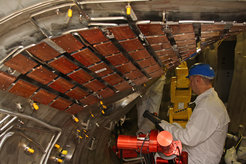The first experimentation phase
December 2015 until March 2016

Since the start of operation in December 2015 plasmas have been continuously produced in Wendelstein 7-X – first from helium gas and, since February 2016, from hydrogen. A tiny quantity of gas has been transformed about 2,200 times by microwave heating into an extremely hot plasma of ultra-low-density, this involving separation of the electrons from the nuclei of the helium or hydrogen atoms. Confined in the magnetic cage of Wendelstein 7-X, the charged particles levitate between the walls of the plasma chamber with almost no contact.
“We are more than satisfied with the results of the first experimental campaign”, stated Project Head Professor Thomas Klinger. Starting off from the then attainable pulse length of half a second, pulse lengths of six seconds were ultimately achieved. The plasmas with the highest temperatures were produced by microwave heating powers of four megawatts lasting one second: At mean plasma densities the physicists were able to measure temperatures of 100 million degrees Celsius for the plasma electrons, and 10 million degrees for the ions. “This greatly exceeded what our rather cautious predictions had led us to believe”, said Thomas Klinger.
Moreover, the structure and confinement properties of the novel magnetic field proved in the first tests to be as good as expected. Further physical investigations, e.g. on the heat load distribution at the wall or on the influence of the external trimming coils, were accompanied by technical discharges for cleaning the plasma vessel or checking the machine systems, viz. magnets, cooling system, microwave heating and machine control.
The experiments were concluded as scheduled on 10 March 2016. The plasma vessel has been re-opened in order to mount 6,000 carbon tiles to protect the vessel walls and insert the divertor
Wendelstein 7-X with clad wall then was fit for high-power plasmas with heating powers of up to eight megawatts lasting ten seconds. After thorough testing of the divertor function the graphite tiles in subsequent extensions are to be replaced by carbon-fibre-reinforced carbon elements that are also water-cooled. This will make discharges of up to 30 minutes possible in which it can be checked at a heating power of 10 megawatts whether Wendelstein 7-X can also permanently achieve its optimisation objectives.
